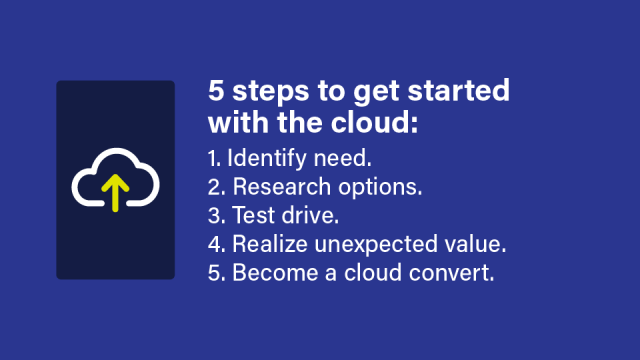When I set out to write a post about a new user’s cloud adoption journey, my research was coming up short.
There were plenty of resources out there about what to do with the cloud and what steps led someone to realize they needed the cloud. But what about directly after? What about one month, six months—even one year—out?
That information? Can’t find it.
So, here’s that article…with a slightly different spin than what you’re used to from us.
Using real customer stories, testimonials and reviews, I’ve written a journal-style post that walks you through what actual users experienced before they decided to move to the cloud…and then what happened afterward.
Let’s have some fun.
Meet Eric (and his drama)
Why? Why is this happening? Every time I turn around, there’s some new crisis that needs to be managed. Work keeps piling up. I know it’s the middle of tax season, but really, is there a way I don’t have to feel incredibly stressed out?
I’m working in the office 70, 80 hours a week right now. I just missed my kid’s spring recital. I’m running around from client to client and making phone calls, too. It’s impossible to get them to send me the paperwork I need. Whenever I try to bring my computer home, everything lags and my system gets kicked off our office server. I don’t know what to do.
The drama! Eric (our composite, based-on-real-events subject) and his pain points aren’t anything new:
- He’s working incredibly hard and doesn’t have time to even think about work-life balance.
- Whenever he tries to leave the office to get some work done from home or any other location, his connection to the in-office server slows or shuts down altogether.
- His clients are old school, prefer paper processes and don’t give him all the info he needs upfront.

Let’s try this cloud thing
I’m not sure why it’s taken me this long to try the cloud at work…but it has. And I’m still not convinced it’ll do that much for me.
I’d been seeing a lot about Rightworks on LinkedIn and Facebook. I’d even been following their blog for a while, but I wasn’t really sure about their product until I tested it out for myself.
Since I mostly work out of QuickBooks®, I decided to discuss options with Rightworks to see which solution would be best for me (without paying for features I don’t need). They advised me to start with OneSpace Firm. I ran it past my partner, and we decided that I’d test it for a bit and bring some others on board if it really proved its worth.
Many—many—people are hesitant about moving their businesses and firms to the cloud.
And we get it; there’s so much technology out there from vendors trying to convince you that their product will change your life. After a while, all that noise turns to static.
That’s why Eric decided to dip his toe in the cloud before bringing anyone else on his team aboard.
His steps included:
- Demoing OneSpace: No sales conversation required, just a good ol’ fashioned self-guided tour of the product.
- Reading G2: Do customers actually like hosting QuickBooks with OneSpace? What’s so great about Rightworks, specifically?
- Setting up a meeting to talk options: Even though Eric knew he wanted OneSpace, he set up a time to talk through pricing. He chose the time himself using Rightworks’ scheduling tool.
- Buying one package: No lengthy contracts meant that if he didn’t like OneSpace, he could cancel it easily. (But that’s not what happened…)
One month in…things are looking good
I’m not sure what I was expecting—an overnight fix to all my challenges, maybe? But so far, I’m really noticing a difference in my day-to-day.
The cutover went smoothly, although I’d barely even call it a cutover. I worked with a super-friendly agent who’d worked with QuickBooks clients for years, and she helped me migrate all my data into OneSpace. It took maybe a few hours, from the time I signed up to the time I started working.
And one month in…things are looking good! I didn’t really believe that having everything stored in one spot would make a difference, but it has. Just knowing that I can pick up my laptop and work from home if I want to, with zero quality degradation or system slow down, is such a load off my mind.
Oh, and the security. I was talking to a prospective client who had originally hesitated about signing up with us because, at that time, we didn’t have any talking points on how our systems protected their data. When I talked to her this time, I told her about the security measures in place with OneSpace. She was sold. I don’t think all clients are going to be that easy to convince, but wow…where’s my easy button?
After being in the cloud for one month, Eric’s noticing some small differences that are starting to add up:
- Annoying system lag? Gone.
- Disorganized company files? Gone.
- Security concerns? Gone.
Six months have flown by…
Has it really been five months since my last entry? Man, time flies.
I’m surprised to admit it, but the cloud has really lived up to the hype. Not because it has all these bells and whistles (it sort of does), but because I don’t have to think about it.
I didn’t have to learn a new way to do my job. Instead, I just launched QuickBooks from a browser instead of my desktop.
I have less to do maintenance-wise, all around. And I don’t have to worry about our in-house server anymore. My software updates are being handled by the Rightworks team now.
These incremental changes don’t seem like much, but I’m telling you: It’s completely shifted how I think about work. Those things that annoyed me so much before—that literally had nothing to do with my job—are gone now. I can just log in, work and log out.
The benefits of the cloud are adding up.
Not because of flashy features—but because he’s offloaded so many of the pesky interruptions that kept him from getting his job done.
At this point, Eric’s been able to:
- Bring his ProSeries clients into OneSpace.
- Invite more staff into OneSpace.
- Work anywhere without his systems performing slower.
- Log into the latest versions of his apps daily.
One year down, many to go
Something big happened this past month: Our first big brush with data loss. Well, it would have been our first big loss, had we not had our backup.
Here’s what happened:
It’s mid-tax season, and I’m up to my ears in returns. I’ve got a prospective new client on the phone, looking to get some more work done. We usually don’t take new clients at this time of year, but I don’t want to be rude—so I stay on the line.
Then, the power goes out. I’m not paying attention to my computer—and I don’t understand exactly how it happened—but when I logged in a few minutes after I hung up the phone, everything I’d done that morning had disappeared. All the progress I’d made in the documents. The client notes I had taken. Everything.
The power comes back, and I call Rightworks support in a panic. And they restore it all. Like nothing had ever happened. They even showed me how to restore it myself if I ever go through this again.
Outages, user error, surges—they happen. And they’re devastating when they lead to lost work.
But when you’re in the cloud, you benefit from routine data backups that save your work in case you do experience any loss.
This past month, in our little based-on-a-true-story anecdote, it happened to Eric. Instead of scrambling and making several awkward client phone calls to get that data back, he just called Rightworks.
Where are you in your cloud adoption journey?
Whether you’re just in the cloud research phase or you landed here because a journal-style blog post piqued your interest, I’m thrilled.
The above story—though admittedly corny at times—illustrates real prospect qualms and customer realizations during their own cloud adoption journeys. First, they’re not sure how things will be any different. Then, they’re just thankful they made the leap to begin with.
If you’re worried about any of the things our story subject was worried about, like…
- Having to learn how to use the cloud.
- That the cloud doesn’t do what it promises.
- That the cloud is a waste of money.
…then set up some time with one of our consultants to talk it through. We’re not here to convince you that you need something you don’t; we’re here to listen to what you want and need…and then see if the cloud would be a good fit.
Until next time,
Kiara (and her alter ego, Eric)



